HOW DO I SET UP AN RTMP SERVER FOR STREAMING VIDEO
Prerequisites for setting up an RTMP server
A few things are required before setting up your streaming server. Selecting a proper server solution should come first. You should provide a lag-free streaming experience and not rely on the performance of your PC or laptop, which you might want to use for gaming simultaneously. Your Internet connection’s bandwidth is crucial in this situation.
Performance of a processor (CPU)
An RTMP server doesn’t require a lot of CPU power. For simple projects, one CPU core could be adequate. The processing power required on a server quickly rises when transcoding is additionally used.
Operative storage (RAM)
Even in terms of Memory usage, an RTMP server is rarely resource-intensive. Even 1 GB may be plenty for modest tasks. For more comprehensive plans, 4 GB is the ideal goal.
Hard drive capacity
The necessary Nginx installation files are relatively small. If you wish to save the streams on the server, you only need to worry about the hard drive capacity. Both the stream’s length and quality are crucial considerations.
Bandwidth
Keep an eye on the bandwidth. Think about the magnitude of streams related to the visual and aural quality. This is multiplied by both the number of streams and the number of viewers. The bandwidth must be bigger to distribute several streams through one server.
Setting up an RTMP server streaming video can be complicated.
However, the fundamental steps are as follows:
1. Clarify the requirements
Knowing what you want from your live streaming server is crucial before learning how to build one.
What size audience do you have?
How significant is the streaming performance?
Do you run Windows, Ubuntu Linux, or Mac OS? What are the prerequisites for your operating system?
Who will be permitted to view the video stream?
You’ll have to make copies of your video feed, right?
The precise next steps will be decided by knowing the answers to these questions.
2. Choose an Open-Source Project
Choose an open-source initiative that supports the media player and delivery protocols you like. Since open-source software is available to assist you in creating a video server, there is no need to design your own code.
The Nginx web server, which functions on Linux, Windows, and Mac OS, is a well-liked and reliable option. Via the Nginx-RTMP module, the Nginx web server may also simply interact with HLS and RTMP.
3. Download OBS Studio to use it on our Server
A fantastic media server software resource is OBS Studio. You will configure your live-streaming software after your server is prepared. You can use OBS Studio, a free and open-source live-streaming server program, for encoding and other live-streaming tasks.
Depending on your operating system, you should download the correct version of OBS Studio.
4. Create a CDN
A content delivery network is the next thing on the list. The latency issue is addressed via CDN. Latency in broadcasting refers to a delay in a live stream or on-demand content. In other words, delivering high-quality live streams to viewers near and far requires a strong video stream CDN.
Once you’ve completed these steps, you can stream the video to your RTMP server. Remember that the exact steps may vary depending on your chosen RTMP server software. Ensuring enough bandwidth and processing power for video streaming is also important.
5. Use the RMP server to Stream video to DECENTRALAND.
Decentraland enables the usage of video player objects for video playback. The URL of the video you want to play can be pointed to by creating a video player entity in your scene. The video player entity can be modified to change both its behavior and appearance.
If you decide to go live streaming for your games, the best option is the RTMP Server we provide. Using our RTMP you will have the best stream. You can also read more on our blog about using our RTMP server to stream videos on Decentraland.
Please note that you have a number of blog posts and tutorials about the RTMP Server. But we will be happy to clarify and questions that may arise. For that open our chat box or create a ticket.


Recent Comments